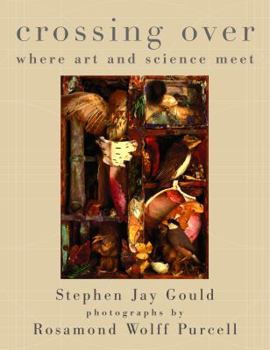Crossing Over: Where Art and Science Meet
Select Format
Select Condition 
Book Overview
Crossing Over, the latest of three collaborations between scholar Stephen Jay Gould and artist Rosamond Wolff Purcell, brings together thought-provoking essays and uncannily beautiful photographs to disprove the popular notion that art and science exist in an antagonistic relationship. The essays and photographs collected here present art and science in conversation, rather than in opposition. As Gould writes in his preface, although the two disciplines may usually communicate in different dialects, when juxtaposed they strikingly reflect upon and enhance one another. Working together, Purcell's photographs and Gould's scientific musings speak to us about ourselves and our world in a hybrid language richer than either could command on its own. In an essay on individuality, for instance, Gould looks through the lens of evolutionary theory to address the controversial issue of cloning and the often misguided fears it evokes. As a society that exalts the concept of the individual, Gould argues, we sometimes fail to recognize that clones walk among us. Identical twins represent "the greatest of all challenges to our concept of individuality." Rosamond Purcell's photograph depicting the famous Siamese conjoined twins Eng and Chang conveys an eerie feeling that cannot be captured in words. Through its unique combination of words and photographs, Crossing Over prompts us to ponder not only the basis of the false dichotomy between art and science, but also the distinction of mind and nature, and of all humanly imposed categories of order. Gould and Purcell's work convinces the reader that a provocative interplay between art and science is not only possible, but inevitable and necessary as well.
Format:Paperback
Language:English
ISBN:060980586X
ISBN13:9780609805862
Release Date:November 2000
Publisher:Three Rivers Press (CA)
Length:159 Pages
Weight:1.84 lbs.
Dimensions:0.5" x 8.6" x 11.0"
Customer Reviews
1 rating
The Inimitable Stephen Gould
Published by Thriftbooks.com User , 17 years ago
What a jewel! I have read all the essays and most of the other works of Gould but this one, while not the deepest or most technical (in fact it is the lightest of all) - is wondrous. The use of art, the meaning and methods and techniques of art, to explain natural selection and the workings of our universe, was ingeniuous. So many times, scientists (Dawkins, etc) shortchange the artistic side of mankind and this is tragic. This side, much more than our intellectual or specifically, scientific, side is what sets us apart as a species. Our ability to rearrange reality and create new forms and pictures and songs and foods that heighten the senses allows us to respond deeply to these external stimuli. In a way, that is what Gould attempts to do on an intellectual level as he discusses symmetry, layers, size, proportion and other mundane ideas presented in a curiously spectacular but low-keyed fashion. The photographs or paintings or drawings fit almost seamlessly with the prose, illustrating the short, intended point. These do not approach the length or depth of the articles yet they are just as effective, maybe more so. Once again, Gould mixes the human, the personal, with the scientific and the artisitc to produce a unified message. My grade - A





